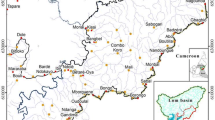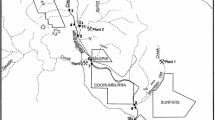Abstract
Large-scale exposure of acid sulfate soils during a hydrological drought in the Lower Lakes of South Australia resulted in acidification of surface water in several locations. Our aim was to describe the techniques used to monitor, assess and manage these acidification events using a field and laboratory dataset (n = 1,208) of acidic to circum-neutral pH water samples. The median pH of the acidified (pH < 6.5) samples was 3.8. Significant (p < 0.05) increases in soluble metals (Al, Co, Mn, Ni and Zn above guidelines for ecosystem protection), SO4 (from pyrite oxidation), Si (from aluminosilicate dissolution) and Ca (from carbonate dissolution and limestone addition), were observed under the acidic conditions. The log of the soluble metal concentrations, acidity and SO4/Cl ratio increased linearly with pH. The pH, alkalinity and acidity measurements were used to inform aerial limestone dosing events to neutralise acidic water. Field measurements correlated strongly with laboratory measurements for pH, alkalinity and conductivity (r 2 ≥ 0.97) but only moderately with acidity (r 2 = 0.54), which could be due to difficulties in determining the indicator-based field titration endpoint. Laboratory measured acidity correlated well with calculated acidity (r 2 = 0.87, acidity present as AlIII >> H+ ≈ MnII > FeII/III) but was about 20 % higher on average. Geochemical speciation calculations and XRD measurements indicated that solid phase minerals (schwertmannite and jarosite for Fe and jurbanite for Al) were likely controlling dissolved metal concentrations and influencing measured acidity between pH 2 and 5.







Similar content being viewed by others
References
Acero, P., Ayora, C., Torrentó, C., & Nieto, J. M. (2006). The behaviour of trace elements during schwertmannite precipitation and subsequent transformation into goethite and jarosite. Geochimica et Cosmochimica Acta, 70, 4130–4139.
Amaral, V., Thompson, E. L., Bishop, M. J., & Raftos, D. A. (2012). The proteomes of Sydney rock oysters vary spatially according to exposure to acid sulfate runoff. Marine and Freshwater Research, 63, 361–369.
ANZECC. (2000). Australian and New Zealand Guidelines for Fresh and Marine Water Quality. Canberra: Australian and New Zealand Environment and Conservation Council and Agriculture and Resource Management Council of Australia and New Zealand.
APHA. (2005). Standard methods for the examination of water and wastewater (21st ed.). Washington, DC: American Public Health Association, American Water Works Association and Water Environment Federation.
Appelo, C. A. J., Van der Weiden, M. J. J., Tournassat, C., & Charlet, L. (2002). Surface complexation of ferrous iron and carbonate on ferrihydrite, and the mobilisation of arsenic. Environmental Science and Technology, 36, 3096–3103.
Baldwin, D. S., Rees, G. N., Mitchell, A. M., & Watson, G. (2005). Spatial and temporal variability of nitrogen dynamics in an upland stream before and after a drought. Marine and Freshwater Research, 56, 457–464.
Ball, J.W., & Nordstrom, D.K. (1991). WATEQ4F—user’s manual with revised thermodynamic data base and test cases for calculating speciation of major, trace and redox elements in natural waters: U.S. Geological Survey Open-File Report 90–129, 185 p.
Bigham, J. M., Schwertmann, U., Traina, S. J., Winland, R. L., & Wolf, M. (1996). Schwertmannite and the chemical modeling of iron in acid sulfate waters. Geochimica et Cosmochimica Acta, 60, 2111–2121.
Boman, A., Fröjdö, S., Backlund, K., & Åström, M. (2010). Impact of isostatic land uplift and artificial drainage on oxidation of brackish-water sediments rich in metastable iron sulfide. Geochimica et Cosmochimica Acta, 74, 1268–1281.
Burton, E. D., Bush, R. T., & Sullivan, L. A. (2006). Sedimentary iron geochemistry in acidic waterways associated with coastal lowland acid sulfate soils. Geochimica et Cosmochimica Acta, 70, 5455–5468.
Burton, E. D., Bush, R. T., Sullivan, L. A., Johnston, S. G., & Hocking, R. K. (2008). Mobility of arsenic and selected metals during re-flooding of iron- and organic-rich acid-sulfate soil. Chemical Geology, 253, 64–73.
Cook, F. J., Hicks, W., Gardner, E. A., Carlin, G. D., & Froggatt, D. W. (2000). Export of acidity in drainage water from acid sulphate soils. Marine Pollution Bulletin, 41, 319–326.
Cravotta, C. A., III. (2008). Dissolved metals and associated constituents in abandoned coal-mine discharges, Pennsylvania, USA: 2. Geochemical controls on constituent concentrations. Applied Geochemistry, 23, 203–226.
Davies, S. H. R., & Morgan, J. J. (1989). Manganese (II) oxidation-kinetics on metal-oxide surfaces. Journal of Colloid and Interface Science, 129, 63–77.
Dent, D. L., & Pons, L. J. (1995). A world perspective on acid sulfate soils. Geoderma, 67, 263–276.
Fitzpatrick, R. W., Shand, P., & Merry, R. H. (2009). Acid sulfate soils. In J. T. Jennings (Ed.), Natural history of the riverland and Murraylands (pp. 65–111). Adelaide, South Australia: Royal Society of South Australia (Inc.).
Fitzpatrick, R.W., Grealish, G., Chappell, A., Marvanek, S., Shand, P. (2010). Spatial variability of subaqueous and terrestrial acid sulfate soils and their properties for the Lower Lakes South Australia, CSIRO Land and Water report. http://www.environment.sa.gov.au/Conservation/Rivers_wetlands/Coorong_Lower_Lakes_Murray_Mouth/The_environment/Acid_sulfate_soils/Research_projects/Acid_Sulfate_Soils_Research_Program_reports. Accessed 22 July 2013
Förstner, U. (1995). Non-linear release of metals from aquatic sediments. In W. Salomons & W. M. Stigliani (Eds.), Biogeodynamics of pollutants in soils and sediments (pp. 247–307). Berlin: Springer.
Hammarstrom, J. M., Sibrell, P. L., & Belkin, H. E. (2003). Characterization of limestone reacted with acid-mine drainage in a pulsed limestone bed treatment system at the Friendship Hill National Historical Site, Pennsylvania, USA. Applied Geochemistry, 18, 1705–1721.
Hammarstrom, J. M., Seal, R. R., II, Meier, A. L., & Kornfeld, J. M. (2005). Secondary sulfate minerals associated with acid drainage in the eastern US: recycling of metals and acidity in surficial environments. Chemical Geology, 215, 407–431.
Hedin, R. S. (2006). The use of measured and calculated acidity values to improve the quality of mine drainage datasets. Mine Water and the Environment, 25, 146–152.
Helsel DR, Hirsch RM (2002) Statistical methods in water resources. In: ‘Techniques of Water-Resources Investigations of the United States Geological Survey; Book 4, Hydrologic Analysis and Interpretation’, 510 pp. http://water.usgs.gov/pubs/twri/twri4a3/. Accessed 22 July 2013
Jenne, A. J. (1995). Metal adsorption onto and desorption from sediments: I. Rates. In H. Allen (Ed.), Metal contaminated aquatic sediments (pp. 81–110). Chelsea: Ann Arbor Press.
Kilminster, K., & Cartwright, I. (2011). A sulfur-stable-isotope-based screening tool for assessing impact of acid sulfate soils on waterways. Marine and Freshwater Research, 62, 152–161.
Kirby, C. S., & Cravotta, C. A., III. (2005a). Net alkalinity and net acidity in mine drainage 1: theoretical considerations. Applied Geochemistry, 20, 1920–1940.
Kirby, C. S., & Cravotta, C. A., III. (2005b). Net alkalinity and net acidity in mine drainage 2: practical considerations. Applied Geochemistry, 20, 1941–1964.
Macdonald, B. C. T., White, I., Åström, M. E., Keene, A. F., Melville, M. D., & Reynolds, J. K. (2007). Discharge of weathering products from acid sulfate soils after a rainfall event, Tweed River, eastern Australia. Applied Geochemistry, 22, 2695–2705.
Milne, C. J., Kinniburgh, D. G., Van Riemsdijk, W. H., & Tipping, E. (2003). Generic NICA—Donnan model parameters for metal-ion binding by humic substances. Environmental Science and Technology, 37, 958–971.
Morel, F. M. M. (1983). Principles of aquatic chemistry. New York: Wiley.
Mosley, L. M., Hunter, K. A., & Ducker, W. A. (2003). Forces between colloidal particles in natural waters. Environmental Science and Technology, 37, 3303–3308.
Mosley, L. M., Zammit, B., Leyden, E., Heneker, T. M., Hipsey, M. R., Skinner, D., et al. (2012). The impact of extreme low flows on the water quality of the Lower Murray River and Lakes (South Australia). Water Resources Management, 26, 3923–3946.
Murray, F. (1984). Fluoride retention in highly leached disturbed soils. Environmental Pollution (Series B), 7, 83–95.
Nystrand, M. I., & Österholm, P. (2013). Metal species in a Boreal river system affected by acid sulfate soils. Applied Geochemistry, 31, 133–141.
Olem, H. (1991). Liming Acidic Surface Waters. Lewis Publishers, 331 pp.
Parkhurst, D.L., & Appelo, C.A.J. (2013), Description of input and examples for PHREEQC version 3—a computer program for speciation, batch-reaction, one-dimensional transport, and inverse geochemical calculations: U.S. Geological Survey Techniques and Methods, book 6, chap. A43, 497 p., http://pubs.usgs.gov/tm/06/a43. Accessed 22 July 2013
Plummer, L. N., Wigley, T. M. L., & Parkhurst, D. L. (1978). The kinetics of calcite dissolution in CO2–water systems at 5 to 60 °C and 0.0 to 1.0 atm CO2. American Journal of Science, 278, 179–216.
Pons, L.J. (1973). Outline of the genesis, characteristics, classification and improvement of acid sulphate soils. In: H. Dost (Ed.), Proceedings of the 1972 (Wageningen, Netherlands) International Acid Sulphate Soils Symposium, vol 1 (pp. 3–27). International Land Reclamation Institute Publication 18. (Wageningen, Netherlands).
Sammut, J., White, I., & Melville, M. D. (1996). Acidification of an estuarine tributary in eastern Australia due to drainage of acid sulfate soils. Marine and Freshwater Research, 47, 669–684.
Shaw, S. A., & Hendry, M. J. (2009). Geochemical and mineralogical impacts of H2SO4 on clays between pH 5.0 and −3.0. Applied Geochemistry, 24, 333–345.
Simpson, S. L., Fitzpatrick, R. W., Shand, P., Angel, B. M., Spadaro, D. A., & Mosley, L. (2010). Climate-driven mobilisation of acid and metals from acid sulfate soils. Marine and Freshwater Research, 61, 129–138.
Stumm, W., & Morgan, J. J. (1996). Aquatic chemistry—chemical equilibria and rates in natural waters (3rd ed.). New York: Wiley.
Sullivan, L. A., & Bush, R. T. (2004). Iron precipitate accumulations associated with waterways in drained coastal acid sulfate landscapes of eastern Australia. Marine and Freshwater Research, 55, 1–10.
Sverdrup, H. U. (1986). The dissolution efficiency for different stream liming methods. Water, Air, and Soil Pollution, 31, 827–837.
Uhlmann, W., Bütcher, H., Totsche, O., & Steinberg, C. E. W. (2004). Buffering of acidic mine lakes, the relevance of surface exchange and solid bound sulphate. Mine Water and the Environment, 23, 20–27.
Acknowledgments
The assistance of EPA staff (David Palmer, Emily Leyden, Peter Mettam, Ashley Natt, Karl Fradley and Jarrod Spencer) in sample collection and analysis is gratefully acknowledged as is the project management assistance of staff from the Department of Environment, Water and Natural Resources. We thank Mark Raven and Peter Self from CSIRO Land and Water for XRD analyses. The part funding contribution of the South Australian Government’s Murray Futures program funded by the Australian Government’s Water for the Future Initiative, and the Murray–Darling Basin Authority are also gratefully acknowledged. We also appreciate the constructive comments of an anonymous reviewer.
Author information
Authors and Affiliations
Corresponding author
Electronic supplementary material
Below is the link to the electronic supplementary material.
ESM 1
(PDF 617 kb)
Rights and permissions
About this article
Cite this article
Mosley, L.M., Zammit, B., Jolley, AM. et al. Monitoring and assessment of surface water acidification following rewetting of oxidised acid sulfate soils. Environ Monit Assess 186, 1–18 (2014). https://doi.org/10.1007/s10661-013-3350-9
Received:
Accepted:
Published:
Issue Date:
DOI: https://doi.org/10.1007/s10661-013-3350-9




